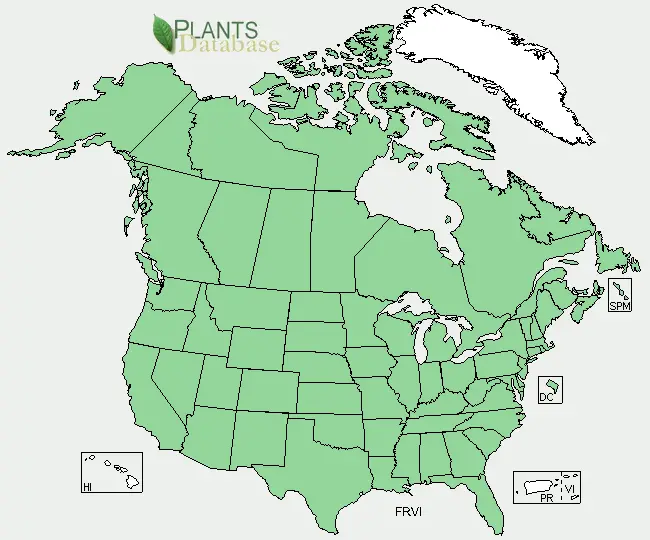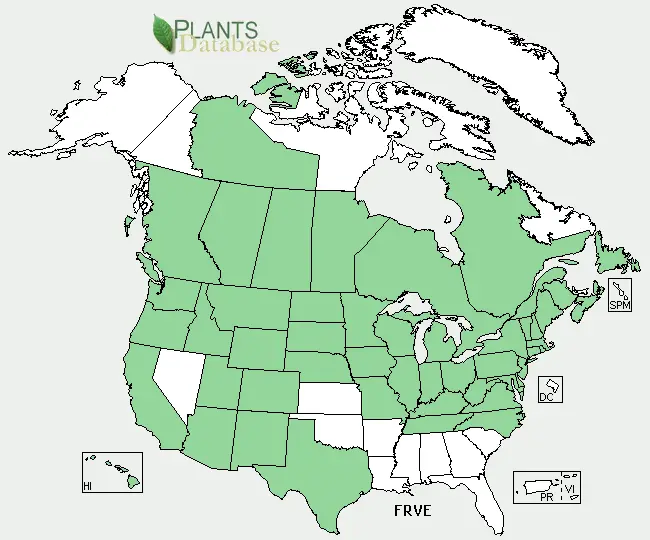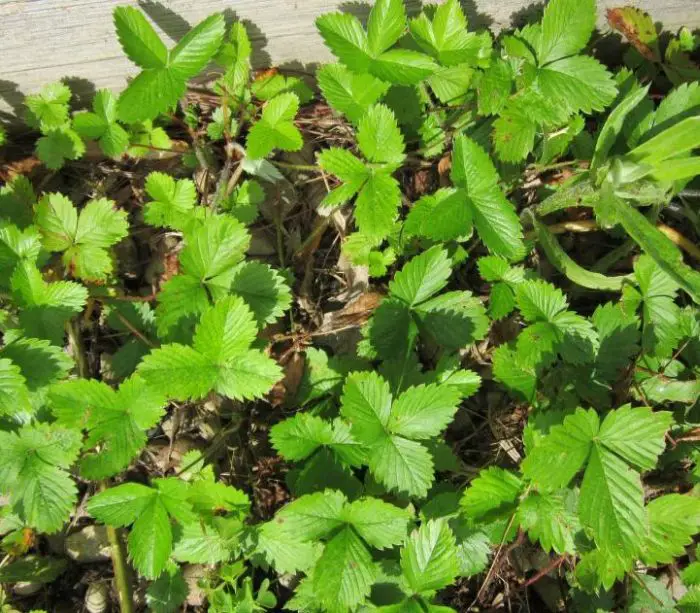
Search Wild Foods Home Garden & Nature's Restaurant Websites:
Strawberries (Wild & Woodland)
(NOTE: If you are not interested in growing Wild & Woodland Strawberries, but just finding the Strawberries, try going to the Nature's Restaurant Online site Strawberries (Wild & Woodland) page.)
Woodland Strawberries (Fragaria vesca). Known also as the Alpine Strawberry, European Strawberry, Hillside Strawberry and Wild Strawberry. Also, Wild Strawberries (Fragaria virginiana). Known also as the Common Strawberry and the Virginia Strawberry. Both are more often than not just called Wild Strawberries.
Is the growing of this plant compatible with Natural farming, Ecoagriculture or Eco friendly agriculture, Ecological farming, Sustainable agriculture, Agroforestry or Agro-sylviculture and Permaculture: Like most perennials, this plant does not require any tilling of the soil after they have been planted, making them ideal to be included in a Natural farming, no-till garden setting.
Identification: Telling the difference is not obvious unless you carefully study them. The Wild Strawberry (Fragaria virginiana) does taste better - very good "Strawberry" flavor, while the taste of the Woodland Strawberry (Fragaria vesca), is duller and less sweet, so knowing how to identify them is a good idea when out looking for some to transplant. On the Wild Strawberry (Fragaria virginiana), the little yellow seeds (achenes technically) are on the surface in pits, or holes, while on the Woodland Strawberry (Fragaria vesca), the seeds (achenes) are on the surface not in pits or holes. On the Woodland Strawberry (Fragaria vesca) the leaf is thicker and tougher feeling and wrinkly looking, where on the Wild Strawberry (Fragaria virginiana), it is thinner and less tough feeling and flatter overall. The serrations on the tips of the leaf are longer than the sides of the Wild Strawberry (Fragaria virginiana) leaf, whereas on the Woodland Strawberry (Fragaria vesca) the serrations are about the same size all around the leaf. Also, in general, the Wild Strawberry (Fragaria virginiana) is lower to the ground than the Woodland Strawberry (Fragaria vesca) - but that can overlap. The Wild Strawberry (Fragaria virginiana) has runners that are up to 60 cm (2 feet) long, while the Woodland Strawberry (Fragaria vesca) has runners up to about 30 cm (1 foot) long.
Oddly, though they are so very similar in most ways, they do not hybridize, as they are genetically unique. One has two sets of chromosomes, while the other has eight.
Identification Caution: When looking for Wild Strawberries to transplant, don't confuse it with the Mock Strawberry Potentilla indica. Unfortunately, the leaves are very similar. Although not native to North America, the Mock Strawberry has been brought here as a garden ornamental and has escaped and naturalized in places in Eastern North America, especially the Southeastern USA. Pictures of the Mock Strawberry on the web here (Google images) and here (Bing images). The Mock Strawberry has yellow flowers, while the Wild Strawberry has white or pinkish-white flowers. Take note when comparing pictures of them that the Mock Strawberry fruit is upright on the stem and has five green little petals (bracts technically) framing it, while the Wild Strawberry hangs down from an arced over stem (stem does a U-turn) and does not have the green petals framing it.
Soil & Site: Both types need a good amount of light, but do fine if there is some shade, especially if the shade is in the day during the heat of the summer. The better tasting one, the Fragaria virginiana, will go dormant in the summer if it is hot and dry, so you will actually get a better harvest if it gets morning and evening sun, but not direct sun during the mid-day during the hot months. Often that is hard to do, however in a container you can just put an umbrella over it, or move it to different places as the seasons change.
Both types can grow in a range of soils, but if you want the biggest fruit, and the largest harvest, plant in soil that has a pH of 6.0 to 6.5, is rich in organic matter, drains well and is kept moist. The soil acidity of pH 6.0 to 6.5 is just slightly acidic, though very close to neutral. I have neutral soil of 7.0, and they do well as I put just a little layer of garden compost on them each fall. Most garden compost, without lime or ash added is slightly acidic.
Seeds: You can buy seeds, though not from garden stores in the spring like most seeds unless you have an amazing garden store. Follow the instructions on the package for starting, but if there are none, I suggest using moist potting soil in 10 cm (4 inch) pots, sprinkle a few seeds on the surface of each, scratch into the soil just slightly, tamp down, keep moist by misting, and keep in good light, but not direct sun. When they are established, transplant to the garden or container you want them in. After transplanting get them used to morning and evening sun slowly, and don't expose them right away to the midday sun. Keep moist, but make sure they don't sit in water.
Transplanting: Transplant a shovel full or two if you can find some in the wild. Since they do taste better, I would focus on finding the Wild Strawberry (Fragaria virginiana). You can purchase cultivars of this plant, though not often through your local nursery. They are not hard to transplant. Just make sure you don't disturb the roots right under the main stem. Cut around with the shovel, pry out, put in a bag and set in a hole where you want them and water well until established. Every time I've moved some, they took quickly.
Cloning: The Fragaria virginiana is fun to start in new pots. They put out runners that can be up to 60 cm (2 feet) long. Where the runner has a terminal point, they will set root. Just put a pot with soil under that point and use a U shaped piece of wire pushed into the soil to lightly hold the runner in place. Keep the soil in the pot moist, and once the new one takes, cut the runner, and you can transplant the new one to a new spot or give away to a friend.
Maintenance: There is no maintenance to be done to them other than a little fertilizer or some compost or composted manure on the area they are growing in the fall or early spring - only use a thin layer each time.
Using: If you like whipped cream over regular strawberries cut up, a nice visual trick for serving is to have a few wild strawberries gathered, put the regular strawberries cut in the bowl, put the whipped cream on top, then a few wild strawberries on the whipped cream. Pick and eat is the way I do it.
Recipe search on the web here (Google search) and here (Bing search).
Wild Strawberries (Fragaria virginiana). This is the better of the two.
- USDA Plant Hardiness Zone: 2-9 (More information on hardiness zones).
- Soil pH: 5.1-7.8
- Plant Size: Low to ground, with runners that root and produce new plants. Generally, no more than 20 cm (8 inches) high
- Duration: Perennial
- Leaf Shape: Trifoliate compound leaf with more or less Ovate leaflets
- Leaf Phyllotaxis (Arrangement) on branch: All leaf stems are basal - they come from a root crown at the surface of the ground, or just below.
- Leaf Size: Around 7.5 cm (3 inches) long by 3.75 cm (1 1/2 inches) wide
- Leaf Margin: Serrated (saw toothed edge)
- Leaf Notes: Pale green on lower surface. Leaf stems and runners can be green to dull red and are hairy
- Flowers: Five petalled white flower with yellow center on about 7.5 cm (3 inch) stems that come from the root crown. Flower about 2 cm (3/4 inch) diameter.
- Fruit: Sweet, very good "Strawberry" flavor. The seeds (achenes) are in little pits or holes on the surface of the fruit.
- Habitat: Near woodlands, likes rich moist, well drained soils, does well in limestone soils, open areas, ditches, waste areas. Because it grows in cool spring and fall conditions and goes nearly dormant in heat of summer, it can survive summer shade.
Web Resources:
- Pictures on the web here (Google images) and here (Bing images).
- Interactive USDA distribution map and plant profile here.
- The Biota of North America Program (BONAP) distribution map here. BONAP map color key here.

Wild Strawberries (Fragaria virginiana) range. Distribution map courtesy of U. S. Department of Agriculture (USDA Natural Resources Service) and used in accordance with their policies.
Woodland Strawberries (Fragaria vesca). This one is the second choice, it does not taste as good as the one listed above.
- USDA Plant Hardiness Zone: 3-9 (More information on hardiness zones).
- Soil pH: 6.6-7.5
- Plant Size: Low to ground - no more than 30 cm (12 inches) high, with runners that root and produce new plants
- Duration: Perennial
- Leaf Shape: Trifoliate compound leaf, each leaflet is more or less Ovate
- Leaf Phyllotaxis (Arrangement) on branch: All leaf stems are basal - they come from a root crown at the surface of the ground, or just below.
- Leaf Size: Each leaflet is 2.5-6.5 cm (1 to 2 1/2 inches) long, and 2-5 cm (3/4 to 2 inches) wide
- Leaf Margin: Coarsely Serrated (saw toothed edge)
- Leaf Notes: Upper leaf surface is medium green, lower leaf surface is light green. Can be finely hairy on both sides or glabrous (hairless)
- Flowers: Five white petals, yellow center on 7.5-20 cm (3 to 8 inches) long stem that can be green or a reddish-purple and covered in hairs. Stems are also basal - they come from the root crown at the ground surface. Flowers late spring until mid summer.
- Fruit: Very small strawberries. Flavour duller and less sweet than the Wild Strawberry (Fragaria virginiana), but never bitter or sour. The seeds (achenes) are on the surface not in pits or holes.
- Habitat: Can be found almost anywhere except exceptionally dry or soaking wet ground. Grasslands, edges of woods, sunny woods, fields, roadsides, hillsides, and as a weed in flower and vegetable gardens.
Web Resources:
- Pictures on the web here (Google images) and here (Bing images).
- Interactive USDA distribution map and plant profile here.
- The Biota of North America Program (BONAP) distribution map here. BONAP map color key here.

Woodland Strawberries (Fragaria vesca) range. Distribution map courtesy of U. S. Department of Agriculture (USDA Natural Resources Service) and used in accordance with their policies.

Woodland Strawberry (Fragaria vesca) plants in late summer after last fruiting.
Search Wild Foods Home Garden & Nature's Restaurant Websites:
Share:
Why does this site have ads?
Originally the content in this site was a book that was sold through Amazon worldwide. However, I wanted the information to available to everyone free of charge, so I made this website. The ads on the site help cover the cost of maintaining the site and keeping it available.
Google + profile
